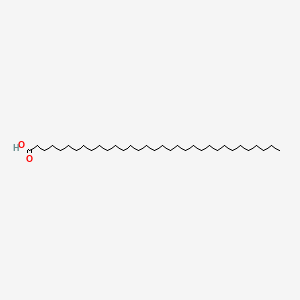| MeSH term | MeSH ID | Detail |
|---|---|---|
| Diabetes Mellitus, Type 2 | D003924 | 87 associated lipids |
| Body Weight | D001835 | 333 associated lipids |
| Hypercholesterolemia | D006937 | 91 associated lipids |
tritriacontanoic acid
tritriacontanoic acid is a lipid of Fatty Acyls (FA) class. Tritriacontanoic acid is associated with abnormalities such as hypercholesterolemia, Metabolic syndrome, Diabetes Mellitus, Non-Insulin-Dependent, Diabetes Mellitus, Insulin-Dependent and Parkinson Disease. The involved functions are known as Fermentation, Process, Longterm Effects, Pressure- physical agent and Lipid Metabolism. Tritriacontanoic acid often locates in Blood, Tissue fiber and A Fibers. The associated genes with tritriacontanoic acid are STN gene. The related lipids are Total cholesterol and blood lipid.
Cross Reference
Introduction
To understand associated biological information of tritriacontanoic acid, we collected biological information of abnormalities, associated pathways, cellular/molecular locations, biological functions, related genes/proteins, lipids and common seen animal/experimental models with organized paragraphs from literatures.
What diseases are associated with tritriacontanoic acid?
tritriacontanoic acid is suspected in hypercholesterolemia, Metabolic syndrome, Diabetes Mellitus, Non-Insulin-Dependent, Diabetes Mellitus, Insulin-Dependent, Parkinson Disease and other diseases in descending order of the highest number of associated sentences.
Related references are mostly published in these journals:
| Disease | Cross reference | Weighted score | Related literature |
|---|
Possible diseases from mapped MeSH terms on references
We collected disease MeSH terms mapped to the references associated with tritriacontanoic acid
PubChem Associated disorders and diseases
What pathways are associated with tritriacontanoic acid
There are no associated biomedical information in the current reference collection.
PubChem Biomolecular Interactions and Pathways
Link to PubChem Biomolecular Interactions and PathwaysWhat cellular locations are associated with tritriacontanoic acid?
Visualization in cellular structure
Associated locations are in red color. Not associated locations are in black.
Related references are published most in these journals:
| Location | Cross reference | Weighted score | Related literatures |
|---|
What functions are associated with tritriacontanoic acid?
Related references are published most in these journals:
| Function | Cross reference | Weighted score | Related literatures |
|---|
What lipids are associated with tritriacontanoic acid?
Related references are published most in these journals:
| Lipid concept | Cross reference | Weighted score | Related literatures |
|---|
What genes are associated with tritriacontanoic acid?
Related references are published most in these journals:
| Gene | Cross reference | Weighted score | Related literatures |
|---|
What common seen animal models are associated with tritriacontanoic acid?
There are no associated biomedical information in the current reference collection.
NCBI Entrez Crosslinks
All references with tritriacontanoic acid
Download all related citations| Authors | Title | Published | Journal | PubMed Link |
|---|---|---|---|---|
| Prasad VG and Abraham P | Management of chronic constipation in patients with diabetes mellitus. | 2017 | Indian J Gastroenterol | pmid:27987136 |
| Okuda Y et al. | Usefulness of Mac-2 Binding Protein Glycosylation Isomer for Prediction of Posthepatectomy Liver Failure in Patients With Hepatocellular Carcinoma. | 2017 | Ann. Surg. | pmid:27355265 |
| Shulman RJ et al. | Psyllium Fiber Reduces Abdominal Pain in Children With Irritable Bowel Syndrome in a Randomized, Double-Blind Trial. | 2017 | Clin. Gastroenterol. Hepatol. | pmid:27080737 |
| Rao MRP et al. | Synthesis and characterization of psyllium seed mucilage grafted with N,N-methylene bisacrylamide. | 2017 | Int. J. Biol. Macromol. | pmid:28512054 |
| Gabrielli F et al. | Psyllium fiber vs. placebo in early treatment after STARR for obstructed defecation: a randomized double-blind clinical trial. | 2016 | Minerva Chir | pmid:26325116 |
| Kaikkonen R et al. | Comparison of psyllium feeding at home and nasogastric intubation of psyllium and magnesium sulfate in the hospital as a treatment for naturally occurring colonic sand (geosediment) accumulations in horses: a retrospective study. | 2016 | Acta Vet. Scand. | pmid:27733202 |
| Abutair AS et al. | Soluble fibers from psyllium improve glycemic response and body weight among diabetes type 2 patients (randomized control trial). | 2016 | Nutr J | pmid:27733151 |
| Wong C et al. | Potential Benefits of Dietary Fibre Intervention in Inflammatory Bowel Disease. | 2016 | Int J Mol Sci | pmid:27314323 |
| Erdogan A et al. | Randomised clinical trial: mixed soluble/insoluble fibre vs. psyllium for chronic constipation. | 2016 | Aliment. Pharmacol. Ther. | pmid:27125883 |
| Jimoh MA et al. | Sodium ion interaction with psyllium husk (Plantago sp.). | 2016 | Food Funct | pmid:27722358 |
